I have to apologise to the guys at the London Hackspace (LHS) in advance for this write up. I visited around a month or so ago and have only just got to writing it up. Whilst kicking around in London with a day to spare, at short notice, I contacted the London Hackspace and asked if I could come visit. Jasper replied pretty quickly and despite the horribly short notice was a very willing and helpful host. Many thanks then to Jasper.
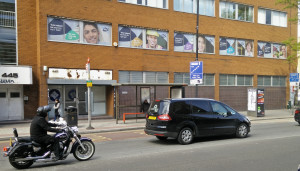
The nearest tube station is Bethnel Green but the walk to the space through Tower Hamlets and past the Museum of Childhood is not very far and it was a pleasant day. LHS can only be described as huge. We were impressed at the size of Nottingham Hackspace but London is actually bigger. Not that size matters…. It leaves our hackspace feeling positively bijou, in true 80’s estate agent speak. The space itself occupies the entire ground floor of the A2E building as pictured, the equally large basement and the whole of the rear yard. Turning up as I did mid-week it was surprising to see how busy the space was with a number of folk working away on their projects.
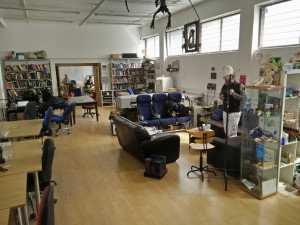
Straight in through the door you walk into the communal chill out area. With a display of things made in the space, comfy seating and the kitchen area featuring a re-purposed fridge/beer cooler and beer on tap. More about the beer later. On the wall dividing this room and the next on this side is a sizeable makers library. Straight ahead through a pair of double doors is a substantial classroom area, with the biggest TV I have ever seen for presentations, apparently gifted by a very generous donor. This classroom area doubles as communal workspace for folk more software oriented when not being used as a classroom. Just out of shot on the left of the classroom is a passage way to the basement stairs and yard door.
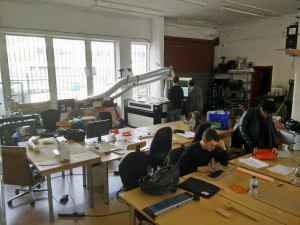
Just off this passage way on the left hand side is the kitchen proper and toilets. Turning immediately left there is the laser and handicraft area, plus the full size roller shutter door to the large rear yard. The yard is just visible through the windows. The area is set up for a bunch of textile oriented projects with a good range of textile oriented machinery and facilities. As I already mentioned, considering it was a midday, and mid-week visit I was pleasantly surprised at how many folk were in the space working on their projects. To the left down the rear wall, again just out of shot is a small quite room/meeting room. Despite there being so much in this open ground floor area the feeling is very light and spacious. So far we have only walked in through the door and turned to our left.
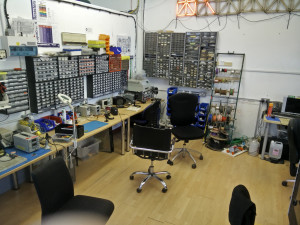
If we turn left again so we are looking behind where we came in we can see the electronics lab. Just out of shot to the right is the 3D printing area, behind which is the quiet room we mentioned earlier. The electronics lab is well appointed with a range of test equipment, soldering stations and a whole bunch of components in drawers. There was a large 16 segment display made up from sticks of LED’s on the rear wall. What was starting to become apparent was that for a busy hackspace with a lot of equipment and ongoing projects it was surprisingly tidy. Before heading down to the basement to see what was in there, Jasper and I took a little time out to have a talk. London Hackspace seem to use IRC quite a bit for extended discussion out side of the space. Questions I had that Jasper was not sure about someone on IRC could help with. Access to the space is via RfID and 24×7. Interestingly enough being London most folk have Oyster cards or some other RfID tag. So the entry system works with these rather than sourcing tags for members to use. Re-purposing starting early. I was curious as to how they managed to have such a large space, especially n London giving the high property and rental costs. Jasper explained that although difficult and a bit of a struggle they do have well in excess of a thousand members. This does sound a lot until you consider just how many folk actually live in London.

Having talked a while we headed for the basement. To the right as you enter the basement area, and extending under the stairs we had just come down, is the biohacking lab, with the appropriate certification. I took this photo through the door glass not wanting to risk contaminating the workspace. Immediately behind me or to the left as you enter the basement is a large storage area with lines of shelving full of storage boxes for donated things to hack upon and personal projects. The basement area appeared to stretch on forever. Maybe it is a tardis like thing, bigger on the inside. Apart form the biohacking lab, this is where the dirtier and dust making work gets done. This lab is the first of a chain of enclosed areas leading from the main work area that make up the right hand side.
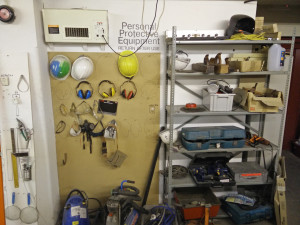
Moving along the right hand side passed a space that is currently a work in progress, we came to the essential stash of Personal Protective Equipment (PPE). As can be seen from the photograph a quantity of this was in use at the time. It was good seeing this in place and the shadow board shows how much is in use. Storing this equipment out of the main mess making rooms helps keep it clean and ready for use. There is a temptation to place it next to the place of use, with the resulting consequences. As appears to be the norm with hackspaces, PPE is provided and it is the members responsibility to select that which is appropriate for the task and use it. This point marks the end of the storage section of the basement and the beginning of the workshop proper.
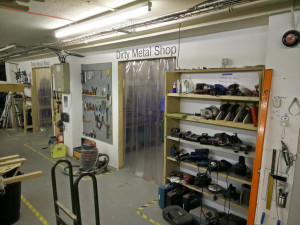
Next in line are the two messier work areas for metal bashing and for woodworking. The metal bashing area has a sub-area set aside for welding and cutting operations. This area can be curtained off with a heavy shade curtain to protect the other workspace users from the effects of welding arc flash and showers of hot metal particles. The usual machine shop equipment is also available together with a power hacksaw. Always useful. The wood working area further along is similarly well provisioned with things like planer/thickeneser, lathe band-saw and workbenches along with dust extraction equipment. Keeping dust and mess levels down in a basement is a challenging pastime. Wood working is a particularly difficult, case in point. The dust extraction was a standard blower and bag type set-up, that could perhaps benefit from a vortex separator.
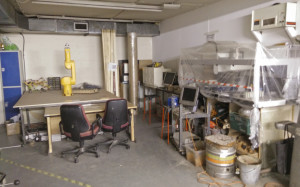
Arrayed just outside the messy workspaces was a goodly selection of hand and power tools for use in either the cleaner workshop area or the messier one. Finally at the end of the right hand side there was a remaining open area with the spaces server racks and a collection of interesting robots. To the right of the picture covered in plastic is one of the bench robots that were used as in the early stages of the Human Genome Mapping Project (HGMP). There were many of these used to brute force the sequencing of a single human genome using the wet bench technology of the day, these were principally used to save on the huge number of man hours that the repetitive tasks would otherwise of consumed.
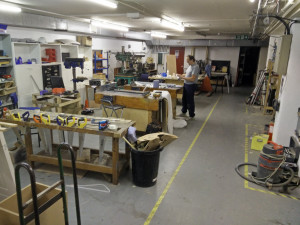
Finally we take a step back and look down the basement taking in the main workshop area that lays down the length of the left hand side. Note the keep clear walkways taped out on the floor. A goodly supply of tooling and workbenches to suit most tasks. The dark door way just visible at farthest end of the room leads to the brewing area. In the brewing area there were stored various iterations of Brewbot and brewing paraphernalia. It was about this point in the tour that something that Jasper had mentioned several times sunk in. In talking about the biohacking, brewing, 3D printing or whatever maker thing etc. Jasper had refereed to them as groups. I guess with that many members and that much space a degree of grouping must take place. Being a small, compact hackspace Sheffield is still pretty homogeneous. We tend to refer new folk to members as individuals that have the skills or interests in common, as opposed to referring them to a group with skills. It was interesting to see how the social structure had evolved and coagulated around specifics. It is almost like a mini town or ecosystem with groups making not just for themselves but for the hackspace at large. The brewing group was a particular case in point, considering their produce was made available to the hackspace in the chill out area upstairs. This left me thinking, this is what community’s and society used to be like before the disruptive model of mass manufacture and mass consumption came to prevail. It was not enough to just sell something, it had to be made as well.
All in all then, wow, what a hackspace. I could do with a visitors pass to drop in the half a dozen times a year I am in London, with time to spare. It would sure beat hanging around the usual touristy parts of town and save me the money spent on impulse buys in Foyle’s Bookshop. A “must go see” for makers visiting London then, and a “must be a member” for makers working, living or spending extended time in London. The number of pictures do not do it justice.
